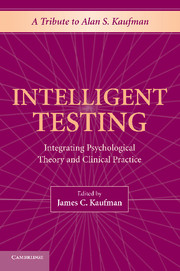Book contents
- Frontmatter
- Contents
- Acknowledgments
- Alphabetical List of Authors and Affiliations
- PART ONE THOSE WHO KNOW HIM
- PART TWO INTELLIGENT TESTING
- PART THREE THE INTERSECTION OF THEORY AND MEASUREMENT
- PART FOUR KAUFMAN ACROSS THE WORLD
- 12 The K-ABC in France
- 13 Dr. Alan Kaufman's Contribution to Japan: K-ABC, Intelligent Testing, and School Psychology
- 14 Alan Kaufman's Deep Influence in Sweden
- 15 Intelligent Testing of Underserved Populations
- 16 Alan S. Kaufman: The Effects of One Man's Extraordinary Vision
- Author Index
- Subject Index
- References
12 - The K-ABC in France
Published online by Cambridge University Press: 05 August 2012
- Frontmatter
- Contents
- Acknowledgments
- Alphabetical List of Authors and Affiliations
- PART ONE THOSE WHO KNOW HIM
- PART TWO INTELLIGENT TESTING
- PART THREE THE INTERSECTION OF THEORY AND MEASUREMENT
- PART FOUR KAUFMAN ACROSS THE WORLD
- 12 The K-ABC in France
- 13 Dr. Alan Kaufman's Contribution to Japan: K-ABC, Intelligent Testing, and School Psychology
- 14 Alan Kaufman's Deep Influence in Sweden
- 15 Intelligent Testing of Underserved Populations
- 16 Alan S. Kaufman: The Effects of One Man's Extraordinary Vision
- Author Index
- Subject Index
- References
Summary
The K-ABC was introduced in France by three researchers (Christiane Capron, Michèle Carlier, and Michel Duyme) who wanted to use a new assessment of cognitive performance for an extensive study of children in France. They decided to translate the mental processing part only. At almost the same time, the publishing house Editions du Centre de Psychologie Appliquée obtained the rights to translate and publish the test. The adaptation of the test was a long process and the researchers and the publisher's research manager Mireille Simon developed an excellent working relationship with M. Carlier and M. Duyme. Moreover M. Carlier and Rose-Marie Bourgault translated the two American manuals. The K-ABC was published in France in 1993, and since then has been used extensively by both practitioners and researchers. The first part of this chapter presents a general report on the use of the French version of the K-ABC by researchers, and reviews studies conducted in France (and probably unknown in North America as many of them were published in French only). The second part contains information on training to use the K-ABC in psychology programs in French universities, and also on the use of the K-ABC by French practitioners.
FRENCH STUDIES USING THE K-ABC
After the French version of the K-ABC was launched, one of the first publications was a book devoted solely to the K-ABC: Kaufman et al., 1994, K-ABC Pratique et fondements théoriques [K-ABC, Practice and Theoretical Foundations].
- Type
- Chapter
- Information
- Intelligent TestingIntegrating Psychological Theory and Clinical Practice, pp. 173 - 182Publisher: Cambridge University PressPrint publication year: 2009



